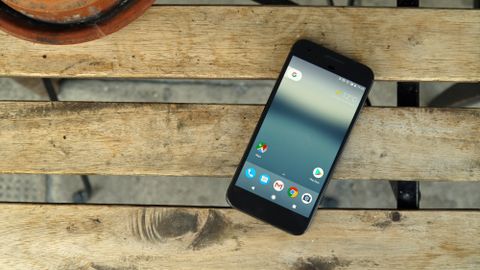Why you can trust TechRadar
Design
- Premium, if slightly odd, looks
- Rear fingerprint scanner is useful
- Metal and glass build makes for a solid smartphone
The Google Pixel design is premium, if slightly odd. There's a metal body, but Google has added a block of glass around the fingerprint scanner and camera on the rear. While this gives the Pixel a unique look, the glass finish does look and feel a little like plastic.
That detracts slightly from the overall appeal of the phone, although the bottom portion of the handset is cool metal – and that's the bit which is in contact with your palm most of the time.
We’d put it below the likes of the Samsung Galaxy S7, iPhone 7 and HTC 10 in terms of looks, but it’s not too far behind, and the metal and glass construction does provide a solid, smart finish. There’s no water resistance though – something the S7 and new iPhone both boast – which is a little disappointing.
It’s more on a par with the larger, cheaper OnePlus 3, which also boasts a premium metal unibody – but with the Pixel being almost twice the price we can’t help feeling Google could have done something even more impressive here.
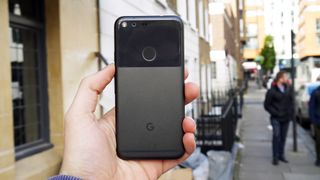
With its modest 5-inch display the dimensions of the Pixel are a palm-friendly 143.84 x 69.54 x 8.58mm. It’s a little chunkier than its rival flagships, but the depth tapers to 7.31mm at the base, which makes it easier to hold in one hand.
The wedge shape this creates is pretty subtle, but hold the Pixel upside down and you’ll notice the added girth of the top of the phone. This does mean the phone is a little top-heavy, but with its narrow width you can grasp the Pixel securely.
We were able to use the Pixel one-handed without issue, although the placement of the fingerprint scanner on the rear is a little frustrating if you want to quickly unlock when the phone is sitting on a desk. It’s a minor blemish, however, and the scanner is easy to reach and very responsive, with speedy unlock times.
And its usefulness isn't limited to unlocking the phone, as you can also swipe down on the scanner to pull down the notification bar on-screen – this is great for those with smaller hands, who may struggle to stretch a thumb to the top of the display. A swipe in the opposite direction will close the bar.
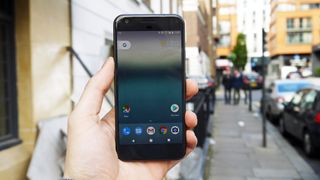
This isn’t the first time we’ve seen this gesture on the digit scanner – Huawei has built it into a number of its phones – but it’s certainly useful once you’re accustomed to it, and we heartily welcome it on the Google Pixel. It wasn’t turned on by default though, so you may need to head to Settings > Moves to enable it.
The power/lock key and volume rocker fall nicely under thumb and finger on the right side of the Pixel, while the nanoSIM tray is the only blemish on the left.
There's bad news for expandable storage fans though, as Google continues to shun microSD on its latest phone – you’ll have to make do with the 32GB or 128GB of internal space.
There is a silver lining to that cloud, however, as Google offers all Pixel owners free unlimited cloud storage for their photos and videos – and at their full resolution – which means you don't need to worry about them taking up vital space on your phone.

On the base of the phone the USB-C port is flanked by two grilles, although only one of those is a speaker – it’s not a dual setup, with the other grille hiding the microphone.
You can pick up the Pixel in three colors – Quite Black, Very Silver and Really Blue – with the cheeky names an obvious pop at Apple’s 'Black' and 'Jet Black' iPhone 7 color options.
Really Blue has been touted as a limited-edition option, though, all versions of the Google Pixel are limited since they're constantly sold out. So we're not sure if it's coming back in stock anytime soon.
There's also good news for audiophiles: Google has kept the headphone jack on the Pixel. Its placement at the top of the handset isn't our favorite location – but at least it's there.
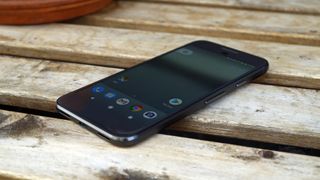
Display
- Bright and colorful – everything looks great on it
- Full HD resolution not the best for VR
The Google Pixel screen is a bright, clear full HD offering stretched across five inches. It's pleasant to view and everything looks great, with a Pixel density of 441ppi – in layman's terms that means it’s pin-sharp.
That's thanks to its 5-inch dimensions, with larger full HD screens tending to lose their clarity a little more - but the Pixel manages to hold it together well here.
We’ve been using the new iPhone 7 and 7 Plus recently, and moving from Apple’s latest offerings to the Pixel we noticed the improved depth of color generated by the latter's AMOLED display.
Some may find it a little over-saturated, but it does make the screen pop with color for a vivid viewing experience.
A slight mark against the display is the fact that the Pixel is Daydream VR-ready, which means it supports Google's new virtual reality platform. The fact that it supports Daydream isn't the issue – we're excited about that and the Daydream View headset – but the 1080p display resolution isn't optimal for VR.
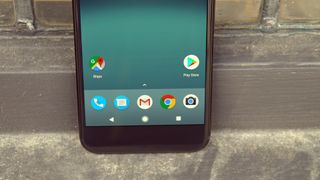
Those who pick up the larger, higher-resolution Pixel XL will get a better Daydream experience, simply because the display can pack more individual pixels into your eyes up close. There's less of the 'screen door effect' going on.
It's not a deal-breaker, and it won't result in a terrible experience if you do opt for a Pixel, but there will be a difference between the two phones.
You also have to consider that the Galaxy S7 and HTC 10 are a touch cheaper than the Pixel, and both pack a QHD display into a similar-sized frame. So, if you're into VR, you may feel short-changed with the Pixel.
Current page: Design and display
Prev Page Introduction and Google Assistant Next Page What’s it like to use?
John joined TechRadar over a decade ago as Staff Writer for Phones, and over the years has built up a vast knowledge of the tech industry. He's interviewed CEOs from some of the world's biggest tech firms, visited their HQs and has appeared on live TV and radio, including Sky News, BBC News, BBC World News, Al Jazeera, LBC and BBC Radio 4. Originally specializing in phones, tablets and wearables, John is now TechRadar's resident automotive expert, reviewing the latest and greatest EVs and PHEVs on the market. John also looks after the day-to-day running of the site.
